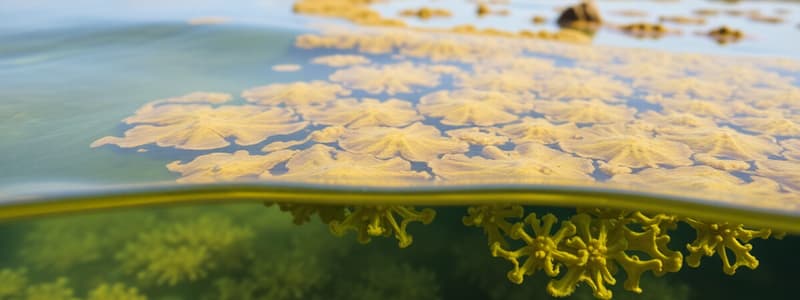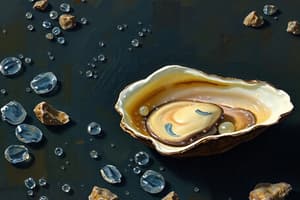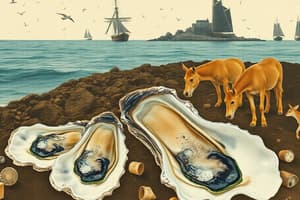Podcast
Questions and Answers
What is a characteristic feature of tropical rainforests regarding precipitation?
What is a characteristic feature of tropical rainforests regarding precipitation?
- They only receive rainfall during specific seasons.
- They have extremely low humidity levels.
- They have wet months with over 30 cm of precipitation. (correct)
- They experience consistent rainfall throughout the year.
Why do tropical rainforests have high net primary productivity?
Why do tropical rainforests have high net primary productivity?
- Annual temperatures and precipitation values support rapid plant growth. (correct)
- They have low temperatures that allow for soil nutrients retention.
- They have a long dry season that encourages growth.
- Their soils are rich in organic matter.
What is a significant environmental challenge faced by tropical rainforests?
What is a significant environmental challenge faced by tropical rainforests?
- Inconsistent rainfall throughout the year.
- The soil is rich in nutrients.
- Drought conditions that promote soil health.
- High rainfall leaches nutrients from the soil quickly. (correct)
Which layer of vegetation is found at the top of a tropical rainforest?
Which layer of vegetation is found at the top of a tropical rainforest?
What adaptation do tropical dry forests have during the dry season?
What adaptation do tropical dry forests have during the dry season?
What distinguishes tropical rainforests from tropical dry forests?
What distinguishes tropical rainforests from tropical dry forests?
Which statement accurately represents the habitat structures within tropical rainforests?
Which statement accurately represents the habitat structures within tropical rainforests?
In which regions are extensive tropical dry forests commonly found?
In which regions are extensive tropical dry forests commonly found?
What is the primary type of tree found in temperate forests?
What is the primary type of tree found in temperate forests?
How does the net primary productivity of temperate forests compare to that of tropical rainforests?
How does the net primary productivity of temperate forests compare to that of tropical rainforests?
What is a significant factor contributing to the nutrient richness of temperate forest soils?
What is a significant factor contributing to the nutrient richness of temperate forest soils?
What climate characteristics define boreal forests?
What climate characteristics define boreal forests?
Which of the following best describes the temperatures in temperate forests?
Which of the following best describes the temperatures in temperate forests?
Which biome is characterized by the prevalence of cold-tolerant cone-bearing plants?
Which biome is characterized by the prevalence of cold-tolerant cone-bearing plants?
What aspect allows more sunlight to reach the ground in temperate forests compared to tropical rainforests?
What aspect allows more sunlight to reach the ground in temperate forests compared to tropical rainforests?
What form of precipitation predominantly affects the boreal forest?
What form of precipitation predominantly affects the boreal forest?
What is a characteristic of the soils in the Arctic tundra?
What is a characteristic of the soils in the Arctic tundra?
During which season does the Arctic tundra experience a burst of productivity?
During which season does the Arctic tundra experience a burst of productivity?
What contributes to low net primary productivity in the Arctic tundra?
What contributes to low net primary productivity in the Arctic tundra?
Which type of plants primarily dominate the tundra landscape during the growing season?
Which type of plants primarily dominate the tundra landscape during the growing season?
What effect does permafrost have on the decay of organic matter in the Arctic tundra?
What effect does permafrost have on the decay of organic matter in the Arctic tundra?
In aquatic biomes, which abiotic factor is not typically associated with terrestrial ecosystems?
In aquatic biomes, which abiotic factor is not typically associated with terrestrial ecosystems?
Which is NOT a characteristic of the aquatic medium compared to air?
Which is NOT a characteristic of the aquatic medium compared to air?
What happens to sunlight as depth in a body of water increases?
What happens to sunlight as depth in a body of water increases?
What characteristic defines the majority of the ocean?
What characteristic defines the majority of the ocean?
Which of the following describes the intertidal zone?
Which of the following describes the intertidal zone?
What is the deepest part of the ocean called?
What is the deepest part of the ocean called?
What factor contributes to the neritic zone having the highest productivity?
What factor contributes to the neritic zone having the highest productivity?
Which organism is adapted to withstand wave damage in the intertidal zone?
Which organism is adapted to withstand wave damage in the intertidal zone?
Which of the following is NOT a characteristic of the neritic zone?
Which of the following is NOT a characteristic of the neritic zone?
Which environmental factor affects organism survival in the intertidal zone?
Which environmental factor affects organism survival in the intertidal zone?
Which zone contains the highest diversity of species in the ocean?
Which zone contains the highest diversity of species in the ocean?
What is the primary environmental challenge faced by organisms in estuaries?
What is the primary environmental challenge faced by organisms in estuaries?
Which type of plant is specifically adapted to thrive in salty conditions in estuaries?
Which type of plant is specifically adapted to thrive in salty conditions in estuaries?
What physiological adaptation do clams exhibit in response to low salinity conditions?
What physiological adaptation do clams exhibit in response to low salinity conditions?
How do mussels and clams switch their respiration method when the salinity drops?
How do mussels and clams switch their respiration method when the salinity drops?
Which of the following best describes the water found in estuaries?
Which of the following best describes the water found in estuaries?
What role do high tides play in the ecology of estuaries?
What role do high tides play in the ecology of estuaries?
What are the main types of freshwater biomes?
What are the main types of freshwater biomes?
What is the significance of the mixing of freshwater and saltwater in estuaries?
What is the significance of the mixing of freshwater and saltwater in estuaries?
What is thermal stratification in lakes and ponds?
What is thermal stratification in lakes and ponds?
Which nutrient is most limiting for phytoplankton growth in lakes and ponds?
Which nutrient is most limiting for phytoplankton growth in lakes and ponds?
What impact do algal blooms have on aquatic environments?
What impact do algal blooms have on aquatic environments?
What type of organisms primarily occupy the photic layer of lakes and ponds?
What type of organisms primarily occupy the photic layer of lakes and ponds?
What happens to temperature layers in lakes during cooling temperatures and winds?
What happens to temperature layers in lakes during cooling temperatures and winds?
Which zone of lakes and ponds is primarily associated with decomposition?
Which zone of lakes and ponds is primarily associated with decomposition?
How do human activities affect the nutrient levels in lakes and ponds?
How do human activities affect the nutrient levels in lakes and ponds?
What role does zooplankton play in lakes and ponds?
What role does zooplankton play in lakes and ponds?
Flashcards
Tropical Rainforests Precipitation
Tropical Rainforests Precipitation
Tropical rainforests have wet months with over 30 cm of rain and dry months with less than 10 cm.
Tropical Rainforest Nutrients
Tropical Rainforest Nutrients
High rainfall in rainforests quickly leaches nutrients from the soil, creating nutrient-poor soils.
Tropical Rainforest Layers
Tropical Rainforest Layers
Tropical rainforests have distinct layers of vegetation: forest floor, understory, canopy, and emergent trees.
Tropical Rainforest Animals
Tropical Rainforest Animals
Signup and view all the flashcards
High Net Primary Productivity
High Net Primary Productivity
Signup and view all the flashcards
Tropical Dry Forests
Tropical Dry Forests
Signup and view all the flashcards
Dry Season Canopy Openings
Dry Season Canopy Openings
Signup and view all the flashcards
Tropical Dry Forest Locations
Tropical Dry Forest Locations
Signup and view all the flashcards
Arctic Tundra Plants
Arctic Tundra Plants
Signup and view all the flashcards
Permafrost
Permafrost
Signup and view all the flashcards
Permafrost Impact on Roots
Permafrost Impact on Roots
Signup and view all the flashcards
Organic Matter Decay
Organic Matter Decay
Signup and view all the flashcards
Nutrient Release
Nutrient Release
Signup and view all the flashcards
Tundra Productivity
Tundra Productivity
Signup and view all the flashcards
Tundra Plant Cover
Tundra Plant Cover
Signup and view all the flashcards
Aquatic Biomes Abiotic Factors
Aquatic Biomes Abiotic Factors
Signup and view all the flashcards
Aphotic Zone of the Ocean
Aphotic Zone of the Ocean
Signup and view all the flashcards
Challenger Deep
Challenger Deep
Signup and view all the flashcards
Intertidal Zone
Intertidal Zone
Signup and view all the flashcards
Neritic Zone
Neritic Zone
Signup and view all the flashcards
Ocean depth average
Ocean depth average
Signup and view all the flashcards
Ocean zones
Ocean zones
Signup and view all the flashcards
Ocean productivity
Ocean productivity
Signup and view all the flashcards
Intertidal organisms adaptation
Intertidal organisms adaptation
Signup and view all the flashcards
Temperate Forest Temperature Range
Temperate Forest Temperature Range
Signup and view all the flashcards
Temperate Forest Precipitation
Temperate Forest Precipitation
Signup and view all the flashcards
Temperate Forest Dominant Trees
Temperate Forest Dominant Trees
Signup and view all the flashcards
Boreal Forest Location
Boreal Forest Location
Signup and view all the flashcards
Boreal Forest Precipitation
Boreal Forest Precipitation
Signup and view all the flashcards
Boreal Forest Plant Types
Boreal Forest Plant Types
Signup and view all the flashcards
Temperate Forest Soil Nutrients
Temperate Forest Soil Nutrients
Signup and view all the flashcards
Boreal Forest Temperatures
Boreal Forest Temperatures
Signup and view all the flashcards
Ecosystem Services
Ecosystem Services
Signup and view all the flashcards
Thermal Stratification
Thermal Stratification
Signup and view all the flashcards
Photic Zone
Photic Zone
Signup and view all the flashcards
Aphotic Zone
Aphotic Zone
Signup and view all the flashcards
Phytoplankton
Phytoplankton
Signup and view all the flashcards
Zooplankton
Zooplankton
Signup and view all the flashcards
Limiting Nutrients
Limiting Nutrients
Signup and view all the flashcards
Algal Bloom
Algal Bloom
Signup and view all the flashcards
Estuary
Estuary
Signup and view all the flashcards
Brackish Water
Brackish Water
Signup and view all the flashcards
Salinity in Estuaries
Salinity in Estuaries
Signup and view all the flashcards
Halophyte
Halophyte
Signup and view all the flashcards
Adaptations of Estuarine Organisms
Adaptations of Estuarine Organisms
Signup and view all the flashcards
Mussel and Clam Adaptations
Mussel and Clam Adaptations
Signup and view all the flashcards
Freshwater Biomes
Freshwater Biomes
Signup and view all the flashcards
Standing Water vs. Flowing Water
Standing Water vs. Flowing Water
Signup and view all the flashcards
Study Notes
Oyster Reef Restoration
- Efforts to clean and restore bays are hampered by pollution originating from other states, highlighting the need for interstate cooperation.
- New oyster strains are boosting aquaculture, improving bay cleaning alongside generating economic value.
The Sulfur Cycle
- Sulfur is crucial in forming proteins, as part of amino acid cysteine.
- The sulfur cycle involves transfer between the oceans, land, and atmosphere.
- Atmospheric sulfur dioxide (SO2) enters the atmosphere from:
- Decomposition of organic molecules
- Volcanic activity and geothermal vents
- Burning of fossil fuels by humans.
- Sulfur is deposited on land via precipitation, fallout, weathering, and geothermal vents.
- Soil sulfates are absorbed by plants, which release sulfur back into the atmosphere as hydrogen sulfide (H₂S) when they decompose.
Terrestrial Biomes
- Two major abiotic factors determine a terrestrial biome: precipitation and temperature.
- Eight major terrestrial biomes exist, each with distinctive characteristics including temperature variations, total precipitation, and fluctuations in precipitation.
- Different biomes can be located in different geographic locations with similar climate profiles.
Tropical Rainforests
- Also known as tropical wet forests, found in equatorial regions.
- Highest diversity of terrestrial biomes.
- Characterized by stable temperatures (20°C-34°C or 68°F-93°F), constant, daily sunlight, and high annual rainfall (250-450 cm or 8.2-14.8 ft).
- Vertical layering of vegetation:
- Sparse forest floor
- Short shrub layer (understory)
- Tree canopy layer.
- High net primary productivity.
- Soils typically have low nutrient content.
- Found in parts of Africa, South America, and Asia.
Savannas
- Grasslands with scattered trees, found in Africa, South America, and Australia.
- Temperate conditions, characterized by average temperatures of 24°C-29°C (75°F-84°F) and rainfall of 51-127 cm (20-50 in).
- A pronounced dry season, leading to frequent fires.
- Plants have evolved well-developed root systems to quickly re-sprout after fires.
Deserts
- Located between 15° and 30° latitude north and south.
- Characterized by low and unpredictable precipitation (fewer than 30 cm or 12 in annually), high temperatures, and high evaporation.
- Low species diversity, with adaptations to conserve water.
Chaparral
- Also known as scrub forest, found in California and the Mediterranean Region.
- Characterized by low annual rainfall (65-75 cm or 25.6-29.5 in), most of it falling during winter.
- Very dry summers.
- Dominated by shrubs, adapted to frequent fires.
- Many plants produce seeds that germinate after fires.
Temperate Grasslands
- Also known as prairies in North America and steppes in Europe.
- Characterized by large fluctuations in temperature (hot summers, cold winters).
- Annual precipitation varies from 25.4 to 88.9 cm (10 to 35 in).
- Dominated by grasses, with few trees due to low rainfall, high frequency of fires, and grazing.
- Rich, fertile soils due to the roots and rhizomes of grasses.
Boreal Forests
- Also known as taiga or coniferous forests, found across Canada, Russia, and Northern Europe.
- Characterized by cold, dry winters, short, cool summers, and low temperatures.
- Annual precipitation ranges from 40-100 cm (15.7-39 in), mostly as snow.
- Dominated by evergreen coniferous trees (e.g., pine, spruce, fir).
Arctic Tundra
- Located in the Northern Hemisphere, also occurs at high elevations in mountainous regions.
- Extremely cold winters and short cool summers.
- Low annual precipitation (15-25cm or 6-10 in), mainly snow.
- Dominated by low-growing plants, including low shrubs, grasses, lichens, and small flowering plants.
- Permafrost (permanently frozen ground) limits the depth plant roots can grow.
Aquatic and Marine Biomes
- Abiotic factors like light penetration, temperature, water flow, and dissolved solids significantly impact aquatic biomes.
- Aquatic biomes include lakes, ponds, wetlands, rivers, and streams (flowing water), including ocean zones (e.g., photic, aphotic, neritic, benthic, abyssal).
Coral Reefs
- Formed by marine invertebrates that live in warm, shallow waters of the photic zone.
- Characterized by a mutualistic relationship between corals and photosynthetic algae.
- Extremely diverse, supporting a large number of species (e.g., fish, invertebrates).
Estuaries
- Where rivers meet the ocean.
- Mixing of fresh and salt water.
- Characterized by high diversity of species adapted to varying salinity levels.
Lakes and Ponds
- Standing water bodies.
- Stratification of water occurs at different temperatures creating layers.
- Light penetration limits productivity to the upper layers.
- Nutrient levels (particularly Nitrogen and Phosphorus) influence primary productivity.
- Algal blooms can reduce oxygen levels.
Rivers and Streams
- Flowing water bodies.
- Abiotic factors like temperature and amount of sediment varied along the length of the stream.
- Gradient, flow rate and water turbidity are important factors.
Studying That Suits You
Use AI to generate personalized quizzes and flashcards to suit your learning preferences.
Related Documents
Description
Explore the intricacies of oyster reef restoration, the sulfur cycle, and the factors influencing terrestrial biomes. This quiz delves into the relationships between pollution, aquaculture, and ecosystem health, along with the essential roles of sulfur in our environment.



